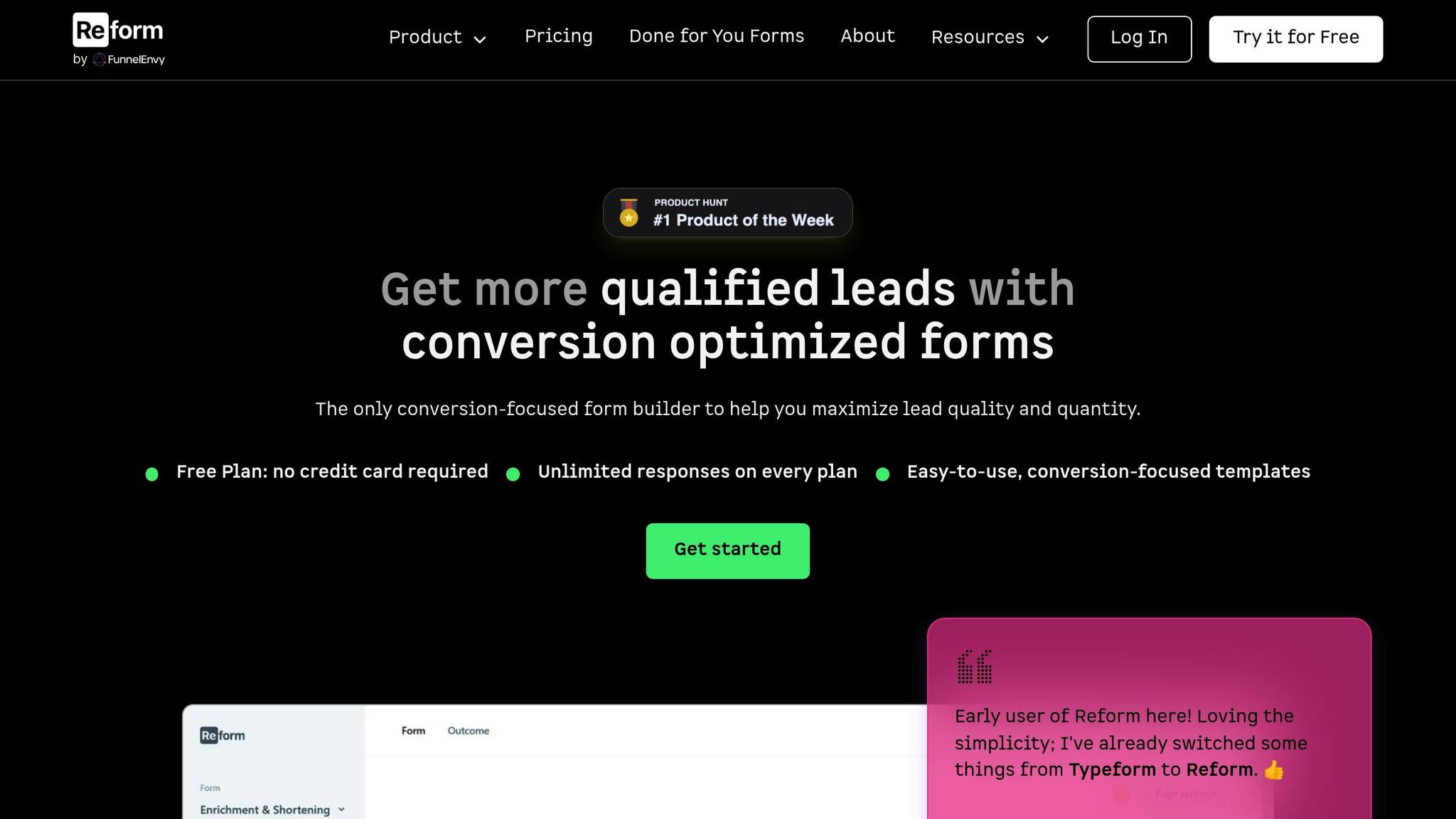NLP for Analyzing Form Responses

NLP (Natural Language Processing) simplifies analyzing form responses by turning unstructured text into structured data, making it easier to spot trends, understand sentiment, and drive decisions. Instead of manually reviewing thousands of responses - an inconsistent and time-consuming approach - NLP automates the process, providing faster, more reliable insights.
Key Takeaways:
- Manual analysis challenges: Inconsistent results, delays, and missed patterns.
- NLP advantages: Automates sentiment analysis, topic detection, and pattern identification.
- Reform integration: Tools like spam prevention, real-time validation, and CRM sync improve data quality and enable real-time insights.
By combining NLP with tools like Reform, businesses can efficiently process large datasets, prioritize customer feedback, and make informed decisions without delays.
Extracting and Visualizing Customer Feedback Data using NLP
Main NLP Methods for Form Response Analysis
Now that we've explored how NLP reshapes form response analysis, let’s take a closer look at the methods that transform unstructured text into clear, actionable insights for better business decisions.
Text Preprocessing and Data Cleaning
Before diving into analysis, raw text responses need to be cleaned up. This starts with tokenization, which breaks text into smaller units like words or phrases. Then comes normalization, where text is standardized by lowercasing, removing punctuation, and fixing misspellings. Filtering out low-value words eliminates terms like "the", "and", or "but" that don’t add much meaning, while reducing words to their base forms ensures variations like "running", "ran", and "runs" are grouped together as "run." Even though advanced NLP tools can handle slang and typos, starting with clean, standardized data ensures more accurate results. This foundation helps NLP systems effectively capture and analyze customer sentiment.
Sentiment and Emotion Analysis
Sentiment analysis helps identify how customers feel about their experiences. Advanced NLP algorithms classify responses as positive, negative, or neutral and can even detect emotions like frustration, satisfaction, or enthusiasm. This insight allows businesses to prioritize leads, address issues proactively, and customize follow-ups based on the mood or tone of a response.
Take this example:
"I love how nutritious all the meals are! Although I had an issue with payment on the website. Delivery was fast too, I got it the next day!"
An NLP system can break this down into specific insights: positive feedback on meal quality, a complaint about payment issues, and praise for fast delivery. This kind of detailed labeling helps teams pinpoint what's working well and what needs attention.
Topic Modeling and Pattern Detection
Topic modeling is like finding hidden themes without needing to define them upfront. Techniques like TF-IDF (Term Frequency-Inverse Document Frequency) identify important words by comparing how often they appear in individual responses versus the entire dataset, highlighting terms that reveal key themes.
Sentence embedding models take it a step further by converting responses into semantic vectors, capturing the meaning behind words. This allows the system to group similar ideas, even if different wording is used - for example, recognizing that "last year" and "over a year ago" convey a similar timeframe.
Algorithms like LDA (Latent Dirichlet Allocation) and pattern matching automatically detect recurring topics, such as pricing complaints or customer service issues. Ambiguous responses that don’t fit into clear categories are flagged for human review, ensuring nothing important slips through the cracks.
When paired with Reform's real-time analytics, these methods become even more powerful. Reform’s tools, like spam prevention and real-time validation, ensure high-quality input, allowing NLP to extract meaningful insights from customer feedback with precision and efficiency.
Using Reform with NLP for Better Form Analytics

Reform takes form data to the next level by combining it with natural language processing (NLP) techniques. This pairing transforms simple form responses into actionable insights, streamlining decision-making and lead management. By addressing challenges like data quality and integration, Reform shifts the process from manual analysis to an automated system that provides real-time insights and supports seamless workflows.
Getting Better Data Quality with Reform
The accuracy of NLP insights hinges on the quality of the data you feed into it. Reform tackles this by offering features that filter out irrelevant data and ensure reliable results.
One standout tool is its advanced spam prevention, which blocks automated submissions and low-quality responses before they even reach your dataset. As Reform explains:
"Keep your leads list clean with advanced spam filters, ensuring that every submission is from a genuine prospect."
This means your NLP models focus on meaningful data, avoiding distractions caused by spam or malicious content.
Another feature, real-time email validation, checks the validity of email addresses as users type. This reduces bounce rates and ensures accurate contact details, which is critical for follow-up communications or lead scoring in NLP workflows.
Reform’s conditional logic takes data collection a step further. By tailoring follow-up questions based on prior answers, it gathers richer, more relevant information. For instance, if a respondent shares a negative experience, the form can prompt them to elaborate on what went wrong - perfect for sentiment analysis and topic modeling.
The platform’s multi-step form design also plays a role in improving data quality. By breaking down complex forms into manageable sections, it encourages thoughtful and complete responses, giving NLP models better material to work with.
Even incomplete submissions aren’t wasted. Reform’s abandoned submission tracking captures partial responses, which can still offer valuable feedback or sentiment indicators. This ensures that no potentially useful data slips through the cracks. High-quality data not only enhances analysis but also enables instant action through CRM systems.
Real-Time Insights and CRM Integration
Reform doesn’t stop at collecting data - it ensures that NLP insights are put to good use. Its integration features make it easy to channel these insights directly into your CRM and marketing tools, eliminating the need for manual handling.
For example, when NLP flags a response with high-value sentiment or identifies an urgent issue, Reform can automatically send this information to your CRM. Imagine a customer feedback form where sentiment analysis detects frustration - Reform can immediately alert your support team for a priority follow-up. Similarly, if positive sentiment aligns with purchase intent, the lead can be routed straight to your sales team.
The real-time analytics dashboard is another powerful feature. It provides instant visibility into trends as they develop. Paired with NLP outputs, this allows you to monitor shifts in customer sentiment, spot emerging issues, or seize new opportunities within hours - no more waiting for weekly reports.
Reform also offers lead enrichment capabilities, gathering additional information about respondents from publicly available sources. This added context enhances NLP analysis by giving algorithms more data to work with. Whether it’s sentiment analysis or topic detection, these enriched datasets improve accuracy and provide deeper insights. Reform even allows for customizable NLP workflows, making lead management more efficient and precise.
Setting Up Custom NLP Workflows with Reform
Reform’s no-code platform makes it easy to create NLP workflows tailored to your business needs - no technical expertise required.
Start by designing your form using features like conditional logic and validation tools to ensure you’re collecting the most relevant data. Once responses come in, Reform’s webhook and integration options connect directly to NLP services, triggering automatic analysis. Results such as sentiment scores, topic categories, or urgency indicators can then be sent back to Reform or forwarded to your CRM.
The platform also supports custom field mapping, letting you organize NLP outputs to align with your processes. For instance, you can create fields for sentiment scores or priority levels that are automatically populated based on analysis. This structured approach makes it simple to filter, sort, and act on insights.
For businesses with advanced needs, Reform’s Pro plan includes support for custom CSS and JavaScript. This opens the door to building tailored interfaces for reviewing NLP results or creating automated decision trees that route leads based on analysis outcomes.
sbb-itb-5f36581
Benefits and Drawbacks of NLP for Form Analytics
NLP has reshaped form analytics, offering a powerful way to manage and analyze responses at scale. However, like any technology, it comes with its own set of strengths and limitations. Understanding both sides can help you make informed decisions about integrating NLP into your workflow.
Benefits of Using NLP for Form Responses
One of the standout advantages of NLP is its ability to process massive amounts of data quickly while extracting deeper insights like sentiment, topics, and intent - details that manual methods often miss. Manual coding can take up to 80% of a researcher's time, but NLP can cut this down significantly, enabling near real-time analysis. This means you can analyze thousands - or even millions - of responses in minutes instead of spending days or weeks.
For instance, a company used NLP to clean and categorize millions of survey responses that mentioned time-related phrases. The system was trained to handle ambiguous expressions like “last year” or “a while back,” resulting in standardized data that revealed meaningful trends. Similarly, in an educator survey, NLP identified recurring themes like exhaustion and widespread concern - patterns that might have been missed with manual analysis.
Another benefit is that machine-learning models improve over time. As you feed them more data, they become increasingly accurate. They can even flag uncertain responses as "Uncategorized", ensuring the integrity of your dataset. This continuous learning makes NLP a long-term asset for analysis.
NLP also reduces bias and labor costs. Unlike manual coding, where results can vary depending on the reviewer, well-trained NLP systems provide consistent and reliable analysis across all responses.
Common Challenges and Limitations
Despite its many advantages, NLP has its share of challenges. Data quality is paramount - misspellings, incomplete sentences, or inconsistent formatting can all undermine the accuracy of NLP models. Even with preprocessing techniques like tokenization and lemmatization, messy input data can lead to unreliable outcomes.
Another challenge lies in dealing with complex or nuanced responses. NLP systems often struggle with domain-specific language, slang, sarcasm, or responses that require a deep understanding of context. For example, while sentiment analysis models might achieve 80-90% accuracy on standard datasets, their performance can drop significantly when working with noisy or highly specialized data.
Technical expertise is another hurdle. Setting up and maintaining NLP models requires access to specialized tools and platforms, as well as knowledge of programming languages like Python and libraries such as spaCy or NLTK. Organizations without this expertise may find it difficult to customize and interpret NLP outputs effectively.
Finally, the setup and training process can be time-consuming and resource-intensive. Building an effective NLP system often requires significant upfront investment, and ongoing maintenance is essential to keep up with evolving language patterns and new terminology.
The table below summarizes these pros and cons:
Pros and Cons Comparison Table
| Pros | Cons |
|---|---|
| Processes large datasets quickly | Requires clean, structured data |
| Identifies hidden patterns and trends | Struggles with ambiguous or complex input |
| Delivers detailed insights (sentiment, topics, intent) | Demands technical expertise for setup and maintenance |
| Enables near real-time analysis | Faces challenges with domain-specific language and sarcasm |
| Reduces manual effort and human bias | Initial setup can be time-consuming and costly |
| Learns and improves with new data | Accuracy decreases with messy or poorly formatted input |
| Handles unstructured, free-text data efficiently | Needs ongoing updates and monitoring |
Reform’s data collection and integration tools can help address many of these challenges. Starting with clean, well-organized data is key to maximizing the benefits of NLP while minimizing its limitations.
Best Practices for NLP Form Response Analysis
Making the most of natural language processing (NLP) involves more than simply running data through algorithms. Your strategy plays a key role in determining the quality of the results. Here are some practical steps to help you get the best outcomes while steering clear of common mistakes.
Start with Clean Data
The quality of your data is everything. Without it, even the best algorithms can't deliver meaningful results. It's the classic case of "garbage in, garbage out."
Preprocessing is a critical step. Tasks like text cleaning, tokenization, and normalization can significantly improve the accuracy of NLP models. Reform's built-in tools make this easier by addressing data quality issues right from the start. For example:
- Real-time email validation ensures accurate contact details, reducing bounce rates and inconsistencies.
- Advanced spam prevention filters out fake submissions, so your models only process genuine responses.
- Lead enrichment capabilities automatically gather extra context about respondents, giving you richer data to work with.
Multi-step forms also play a role in improving data quality. By requiring users to complete multiple steps, these forms naturally reduce spam and encourage more thoughtful, genuine responses. All of these measures ensure that your data is primed for insightful analysis.
Focus on High-Value Questions
Once your data is clean, the next step is to focus on the questions that matter most. Not every form field deserves equal attention, so it's important to prioritize questions that directly influence business decisions.
Research shows that up to 80% of survey data consists of unstructured text. Instead of trying to analyze everything, zero in on responses that are most likely to drive actionable insights. For instance, questions about customer satisfaction or product usability often reveal trends that can shape product development or marketing strategies.
Imagine a customer response like, "I love the fast delivery but had issues with payment." NLP can break this down into categories such as "Delivery: Positive" and "Payment: Negative", helping you pinpoint specific strengths and areas for improvement.
Reform’s conditional routing and multi-step forms make this process even more effective by presenting follow-up questions based on previous answers. This targeted approach ensures you’re gathering deeper insights on the topics that align with your business goals.
Improve and Optimize Over Time
NLP models aren’t something you can set up once and forget about. Language evolves, business needs shift, and new terminology emerges. To maintain accuracy, you’ll need to retrain and validate models regularly.
Keep an eye on key performance metrics like accuracy, precision, and recall to track how well your system is performing. Also, measure the business outcomes tied to NLP insights, such as higher customer satisfaction scores or faster response times.
Reform’s real-time analytics provide instant feedback on how users interact with your forms, making it easier to spot changes in language patterns or emerging themes. When you notice these shifts, you can update your NLP models to stay current.
A/B testing can also help refine your NLP workflows. Experiment with different form designs or question phrasing to identify what generates more consistent and analyzable responses. This not only improves data collection but also enhances the overall analysis process.
For seamless updates, automated integration ensures that your NLP workflows always have access to the latest responses. Even incomplete submissions can offer valuable insights into user intent and common obstacles, so don’t overlook them when refining your models.
Finally, handle ambiguous responses with care. Use fallback categories like "Uncategorized" for responses that your models can’t confidently classify. This prevents mislabeling and highlights areas where further training or manual review might be needed. By continuously optimizing your NLP workflows, you’ll be better equipped to support strategic decisions with reliable, actionable insights.
Conclusion: Getting Business Insights with NLP and Reform
When paired with a platform that ensures clean and structured data, NLP has the power to completely reshape how businesses understand their customers. Reform's approach to form building sets the stage for this transformation by ensuring high-quality data is available right from the start. Together, this combination unlocks actionable insights that can drive meaningful business outcomes.
NLP can process millions of free-text responses, categorizing them at scale into structured data sets. Combine this with Reform's built-in spam prevention and email validation, and you eliminate much of the "noise" that often complicates analysis. This setup ensures your NLP models focus on uncovering real insights instead of filtering out fake or irrelevant submissions.
Reform’s lead enrichment feature adds contextual details about respondents, enabling a deeper layer of analysis. For example, instead of just reviewing feedback in isolation, you can connect sentiment or topics to demographic data, like company size, for a more nuanced understanding of trends.
Real-time analytics and seamless CRM integration turn these insights into immediate actions. For instance, you can prioritize support for unhappy customers or address recurring issues without delay. Unlike traditional workflows - where data is exported, processed through separate tools, and analyzed days later - Reform enables you to act on insights almost instantly.
Consider the example of a SaaS company that boosted its lead-to-customer conversion rate by 15%. NLP flagged recurring onboarding challenges, prompting the company to send targeted support emails, which addressed those issues directly.
Reform also enhances data collection with features like conditional routing and multi-step forms. These tools encourage richer responses, and even partial submissions can reveal user intent or highlight potential obstacles. This creates a feedback loop between data collection and analysis, allowing you to refine forms based on emerging trends and continuously improve the quality of your data.
With automated, real-time analysis, businesses can respond to customer sentiment within hours instead of weeks. This speed provides a competitive advantage, enabling businesses to adapt quickly to changing customer needs and market conditions.
Reform’s integration ecosystem takes this a step further, transforming static form responses into actionable business strategies. Whether it’s updating CRM records, launching marketing campaigns, or notifying support teams, this end-to-end workflow turns raw data into a powerful tool for driving business improvements.
FAQs
How does NLP make analyzing form responses more accurate and efficient than manual methods?
Natural Language Processing (NLP) takes form response analysis to the next level by automating the process of pulling out critical insights from text-based answers. This not only saves time but also minimizes the risk of human error. With NLP, you can uncover patterns, categorize responses, and even gauge sentiment, offering a more detailed look at user feedback.
Compared to manual analysis, NLP handles large datasets at lightning speed while maintaining consistency and eliminating bias. This allows businesses to zero in on meaningful insights, streamlining decision-making and boosting overall productivity.
How does Reform improve data quality and support NLP analysis of form responses?
Reform improves the quality of data and strengthens NLP analysis with features such as advanced spam prevention, which ensures that responses are authentic, lead enrichment, offering deeper insights about respondents, and email validation, confirming the accuracy of contact details. These tools work together to make sure the data collected is dependable and ready for generating actionable insights through NLP.
What challenges do businesses face when using NLP to analyze form responses, and how can they address them?
Integrating NLP into form response analysis comes with its fair share of challenges. Issues like inconsistent data quality, limited technical expertise, and the difficulty of scaling for large datasets can complicate the process. For instance, poorly structured or messy responses can make it tough for NLP models to deliver meaningful insights. At the same time, a lack of in-house expertise might slow down implementation or optimization efforts.
To tackle these hurdles, businesses can take a few practical steps. First, focus on cleaning and standardizing data before feeding it into NLP models - this step significantly boosts accuracy. Using no-code, user-friendly tools can also make NLP more accessible, even for teams without technical backgrounds. Lastly, starting with smaller projects and gradually scaling up allows organizations to manage resources effectively while building confidence in their NLP capabilities.
Related Blog Posts
Get new content delivered straight to your inbox

The Response
Updates on the Reform platform, insights on optimizing conversion rates, and tips to craft forms that convert.
Drive real results with form optimizations
Tested across hundreds of experiments, our strategies deliver a 215% lift in qualified leads for B2B and SaaS companies.


.webp)



